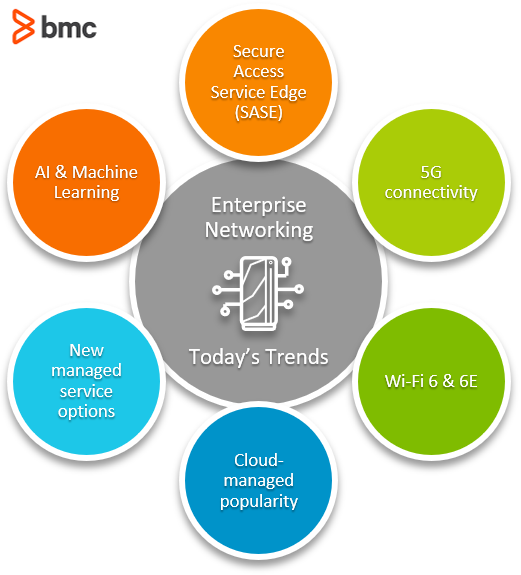Think of the Enterprise Network as the internet, except that it’s local to your organization.
An enterprise network helps employees and machines communicate, share files, access systems, and analyze the performance of an IT environment that drives business operations. Enterprise networks are configured to:
- Connect a limited number of authorized systems, apps, and individuals.
- Enable a secure and efficient communication channel to perform specific business operations.
In this article, we will discuss the enterprise network, how it helps the business, and industry-proven best practices to run secure, high performance, and highly dependable enterprise networking systems.
What is an enterprise network?
The term ‘enterprise network’ refers to the physical, virtual, or logical connectivity infrastructure that enables systems and apps to:
- Communicate
- Share information
- Run services and programs
- Analyze system performance
The enterprise network effectively comprises the infrastructure, hardware and software systems, and the communication protocols used to deliver end-to-end services. The network (or its subset) may be architected, designed, deployed, optimized, and configured to perform a unique set of business and technical objectives.
To establish an enterprise network at geographically disparate locations, use Virtual Private Networks (VPNs) to connect these regions.
(Understand IT infrastructure and cloud infrastructure.)
Types of enterprise networks
Some of the common types of enterprise networks include:
- Local Area Networks
- Wide Area Networks
- Cloud networks
Local Area Network (LAN)
A LAN is a computer network that interconnects systems within a small building or room. Typically used for personal, non-commercial use cases, LANs can also be used as small-scale prototyping or testbed networks.
You can also establish LANs logically and virtually within a larger network. For example, each department within the enterprise network can operate a small LAN where multiple computers are connected to the same switch but decoupled from other departmental LANs.
Wide Area Network (WAN)
Think of a LAN that spans across buildings and disparate geographic locations—even globally.
WAN connectivity differs from LANs in terms of the protocols and components across the layers of the OSI model used to transmit data. While LAN technologies are used to transmit data at higher rates within close proximity, WANs are set up for communication that is:
- Long-distance
- Energy efficient
- Secure
- Dependable
WANs can be deployed as a private or public network and are usually set up by the internet service providers (ISPs).
You can also have a software-defined WAN, or SD-WAN. This is a virtual WAN architecture controlled by software technologies that create an abstraction of the virtualized WAN from the underlying infrastructure components. This technology enables secure WAN operations while decoupling the performance from the underlying components.
An SD-WAN offers more flexible and dependable connectivity services that can be controlled at the application level, without sacrificing security and quality of service (QoS).
(Learn more about software-defined networking.)
Cloud networks
Most enterprise IT services are delivered from data centers and cloud networks. The IT environment may be a hybrid mix of on-premise servers and off-site cloud networks. The cloud stack may consist of multiple cloud computing models—private, public, and hybrid cloud.
Additionally, you likely employ multi-cloud services to deliver various application components and services as an optimal tradeoff between cost, performance, and security offered by different cloud models.
The infrastructure components and software technologies enable the connectivity between data center hardware, applications. and services running across these various IT environments. The cloud resources and the services running on the hardware are accessed and controlled over the internet, usually through private and secure network channels (unless used for public-facing applications).
Conceptually, cloud networks can be seen as a WAN (often an SD-WAN) that may comprise multiple subset of networks shared or distributed privately among customers of cloud computing services.

Benefits of enterprise networking architecture
The networking architecture of your enterprise is the digital foundation for your organization. It enables the agility you need and provides security that evolves to stay ahead of changing threats. Functionally, it provides the connectivity between people, devices, applications, and data to optimize operations and empower innovation.
The right networking architecture supports long-term growth and helps your organization thrive with these core benefits:
- Always-on connectivity: It provides continuous access to data, systems, and applications in distributed environments, both remote and on-site.
- Optimized user experience: In managing traffic intelligently, it gives users access to the tools they need quickly and without fail.
- Readiness for digital transformation: It enables you to be future-ready and able to integrate and use the latest technologies like IoT, AI, and edge computing.
- Easier network management: It simplifies network configuration, monitoring, and troubleshooting with automation and tools for managing complex environments.
- Enhanced security: In using the latest technology and complying with multiple security frameworks, it offers enhanced protection against threat actors and their exploits.
- Flexible software subscriptions: It removes the need to invest in new hardware to scale operations or to use the latest features and applications.
- Seamless cloud integration: It provides the dependable, secure, and uninterrupted connectivity essential to modern IT operations, whether in public, private, or hybrid cloud environments.
Enterprise networking services, trends, and concepts
Already embarked on your enterprise networking strategy? It can be interesting to follow some of the latest trends in the enterprise networking domain.
Today’s technology advancements and improvements are generally centered around service dependability, security, and readiness to integrate new technology standards and systems.
Some new innovations and trends include:
- Secure Access Service Edge (SASE). This network architecture introduces an additional security layer for edge network technologies.
- 5G connectivity. With significant investments and adoption recently, the new 5G networking standard is set to reach maturity in coming years. Organizations taking advantage of the technology are early adopters and disruptors, especially since 5G connectivity offers significantly better user experience with high data transmission rates.
- Wi-Fi 6 and 6E. These new connectivity standards are around 30% faster than Wi-Fi 5. They’re especially useful for simple in-house LAN implementations.
- Cloud-managed popularity. According to a recent IDC publication, cloud-managed WAN, SD-WAN, and Unified Communications adoption continues to rise.
- Managed service options. New service delivery models, like Networking as a Service (NaaS), enable organizations to leverage advanced enterprise networking capabilities on a subscription cost basis.
- AI and machine learning. AI- and ML-enabled enterprise networking will greatly enhance visibility and control into enterprise networks and the IT infrastructure that generates a vast deluge of information at every node and network endpoint.
(See how ML supports data center network security.)
Related reading
- BMC IT Operations Blog
- The Network Operations Center (NOC): How NOCs Work
- IT Infrastructure Management Explained
- Building an IT Network for a Remote Facility
- Network Engineer vs Network Administrator: Roles, Responsibilities & Job Descriptions
- The Empowered Edge: An Introduction
These postings are my own and do not necessarily represent BMC's position, strategies, or opinion.
See an error or have a suggestion? Please let us know by emailing [email protected].






